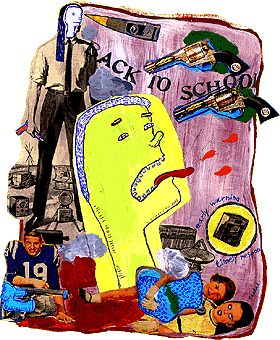
Idid something unusual my senior year of high school: I carried a see-through book bag to class and walked through a metal detector. This was in 1990, when Saddam Hussein rattled his saber under the desert sun, kids packed heat to school, and George Bush's popularity prompted pundits to predict that there would be no beating him. It was a violent age; thank God it's over.
Today, students are less likely to get shot in school than they were in 1990. Schoolyard psychos may be all the rage these days, but the fact of the matter is that in-school murders peaked during the 1992-93 school year at 55 homicides, and have been declining ever since. Even counting the Klebold/Harris killing spree at Columbine High School, only 24 children were murdered at school during the last school year. But unlike 1990 or 1993, today's victims and offenders alike tend to share a paler shade of melanin than did their predecessors in the early '90s. Let the hysteria commence, white people.
We begin our combustible journey with a visit to the Department of Justice's Web site, where a scrolling banner reads "Early Warning/Timely Response: A Guide To Safe Schools." Next up is a trip to the Office of Juvenile Justice and Delinquency Prevention, where the ubiquitous scrolling banner reads "Promising Practices for Safe and Effective Schools."
Hmmm... the government seems concerned. Should I panic? Yes. But not for the reasons you think.
Panic because districts reacting to the need for safer schools are going about it in all the wrong ways. Ken Trump, who has been specializing in school security since long before Larry King and his cronies realized that it was a problem, points out that "good security and crisis preparedness is a process, not an event."
Nonetheless, security services, many of which have seemingly sprung up overnight, are capitalizing on the hysteria to hawk their wares. Metal detectors, security cameras, lockdowns during school hours, and even see-through lockers are quickly becoming de rigueur for today's fashionable school district.
Some schools, such as Columbine, have implemented tip lines that allow students to call in and rat out their maladjusted friends or foes. One company has even gone so far as to send geeks into a coding frenzy in order to develop school security software that allegedly make schools safer places by allowing administrators to "record, track and manage crime prevention in schools."
And all the while, some nuts are advocating arming teachers.
With metal detectors ranging in price from $100 for handheld units to a few thousand for walk-through systems, they're not a practical solution for most schools. The handheld detectors are too small to realistically screen every student, while the walk-throughs are cost-prohibitive to many districts.
Security cameras are great if you want to bust kids smoking dope in the hallway, but they don't really provide additional security. Cameras do, however, promise to catch the actions of potential killers on tape so that your local news can replay all the gory highlights in slo-mo, increasing the perps' media exposure.
Trump shares an amusing anecdote about one school where he acted as a consultant: They'd placed 25 cameras throughout the school to bolster security. However, in a visual version of a tree falling in secluded woods, the school did not have the budget to hire someone to monitor the cameras, and it wasn't even recording the footage on videotape. It's all in the implementation.
Mat Honan is a Senior Editor at GettingIt. He carries Georgia Firearms License number 96-339.
